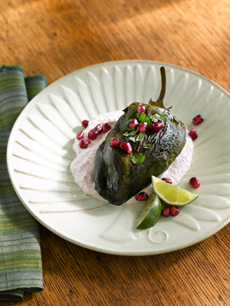TIP: Spice Up Your Diet With Chiles

|
Here’s a healthy food tip for the new year: Check out the health benefits of chiles and add more chiles to your diet.
Chiles originated in Central and South America, where they have been cultivated for more than seven thousand years. They were first used as a decorative item, then became a foodstuff and a medicine. Christopher Columbus encountered them in the Caribbean Islands and brought them back to Europe, where they were used as a substitute for pricey black pepper from India. Ferdinand Magellan is credited with introducing chili peppers into Africa and Asia on his voyages. Now, chiles are grown on all continents, and incorporated them into world cuisines. Here are ways to use five popular chile varieties: chiles in adobo, habanero, jalapeño, poblano and dried chiles. Here are some tips from Whole Foods Market: For a fun project, dry your own fresh chiles; then grind them into chili powder as needed. You can hang them in the sunlight to dry (the most fun) or use the oven or a dehydrator. Here are instructions. If you garden, you can grow your own chiles as well. |
|
|
GET A BOOK The best way to add more chiles to your meals is to start with a book that shows all the possibilities. Our favorite cookbook in the category is The Great Pepper Cookbook, a thorough guide to choosing and cooking with peppers. From mild to hot and hotter, the book explains how to choose, prep and cook 37 varieties of fresh and dried chiles. The recipes are splendid and the photos are gorgeous. They make you want to prepare every recipe. To start you off, here are some pairings with mild chiles that favored by Steve Lindner, Executive Chef and Founder of Zone Manhattan. Chef Steve uses the cubanelle chile to make a version of Chili Verde, a stew from northern Mexico. Originally made with pork, it can be made with chicken as well. Serve it with a whole grain and vegetable sides. Ingredients 1. CUBE the chicken and sear in a pot. Add the onion and garlic. 2. COVER with the wine and vinegar. Simmer until soft. Taste and add salt and pepper as desired. Serve with garnishes. |
||
|
PEPPERONCINI RECIPE: COCONUT & SHRIMP CEVICHE You can do much more with pepperoncini than add them to a Greek salad. Coconut and shrimp are a popular combination, but you can make ceviche with scallops or any fish. Here’s more about ceviche. Ingredients 1. COMBINE the first four ingredients and marinate for several hours or overnight. Taste and add salt as desired. 2. TOP with the coconut and serve with the garnishes. Chiles were “discovered” in the Caribbean by Christopher Columbus, who called them “peppers” (pimientos, in Spanish) because of their fiery similarity to the black peppercorns with which he was familiar. However, there is no relationship between the two plants (or between chiles and Szechuan pepper, for that matter). “Pepper” is a misnomer, but in the U.S., it seems to have taken over. Some people use “chile pepper,” a bit of a correction, still not accurate. Here’s more on the history of chiles. The term “pepper” is not used in Latin America. There, the word is chili, from chilli, the word in the Nahuatl language of the Aztecs. The original Nahuatl word is chilli. The conquering Spanish spelled it chile. In the U.K., chilli is the popular spelling. In the U.S., many people use chili, a seeming middle ground between chilli and chile. |
|
|
|
Now that you know, the choice is yours. We choose “chile” because it’s the spelling by which Europeans were introduced to the chilli, and the best variant of that word. How many types of chiles have you had? Check them out in our Chile Glossary.
|
||


